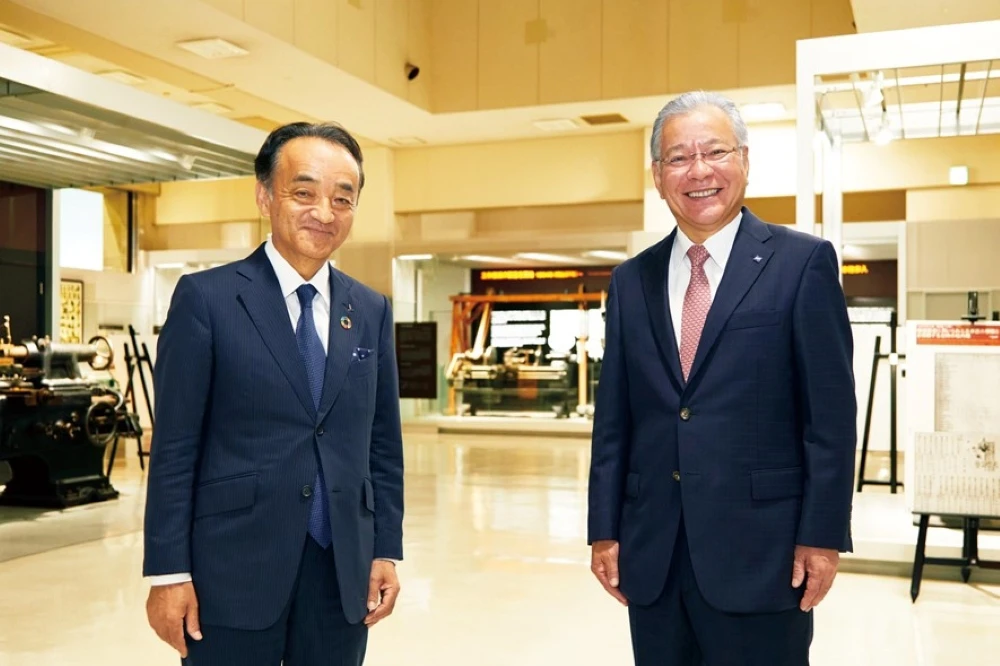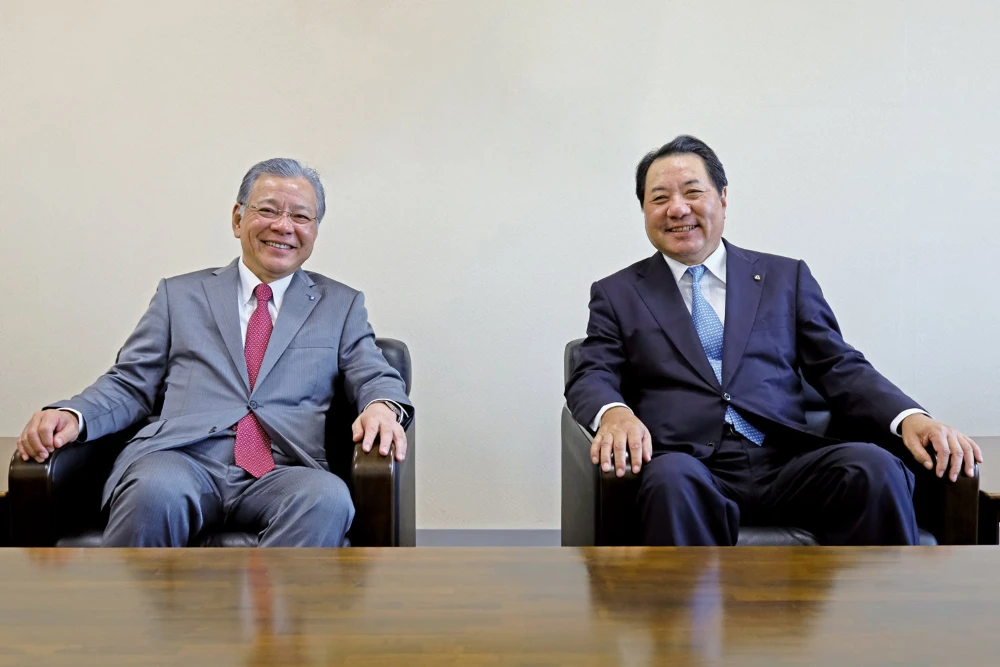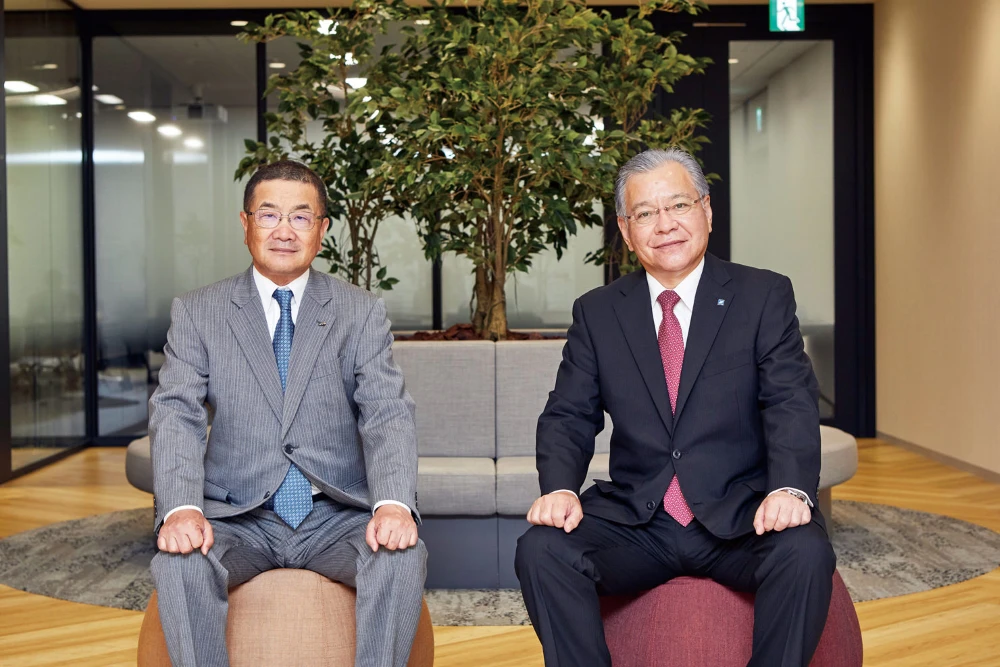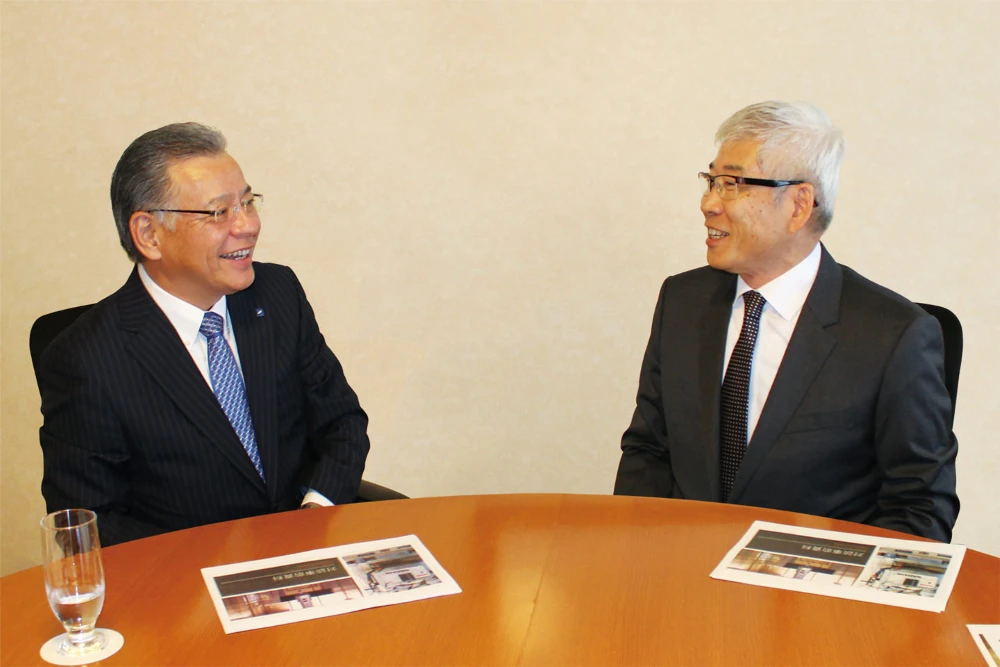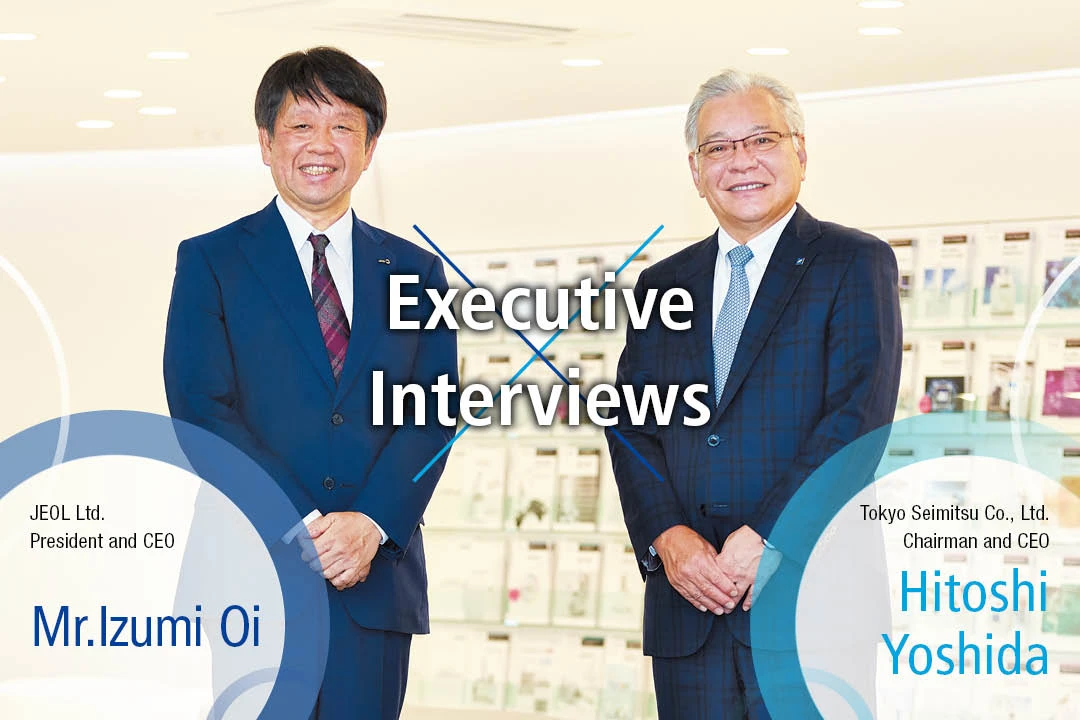
Began operation in 1944 in Midorigaoka (current headquarters) in Toyota city, Aichi prefecture. Mainly produces bearing products and aluminum die-cast products to support the automotive industry. Practices vertically integrated production for a variety of products and leverages this approach, which fuses diverse manufacturing technologies (e.g. casting, precision processing, mounting, assembly, and conveyance) with advanced quality control technologies to swiftly respond not only to existing product needs but also to the launch of new products.
The Men Who Carved the Future of Monozukuri Talk about the Now
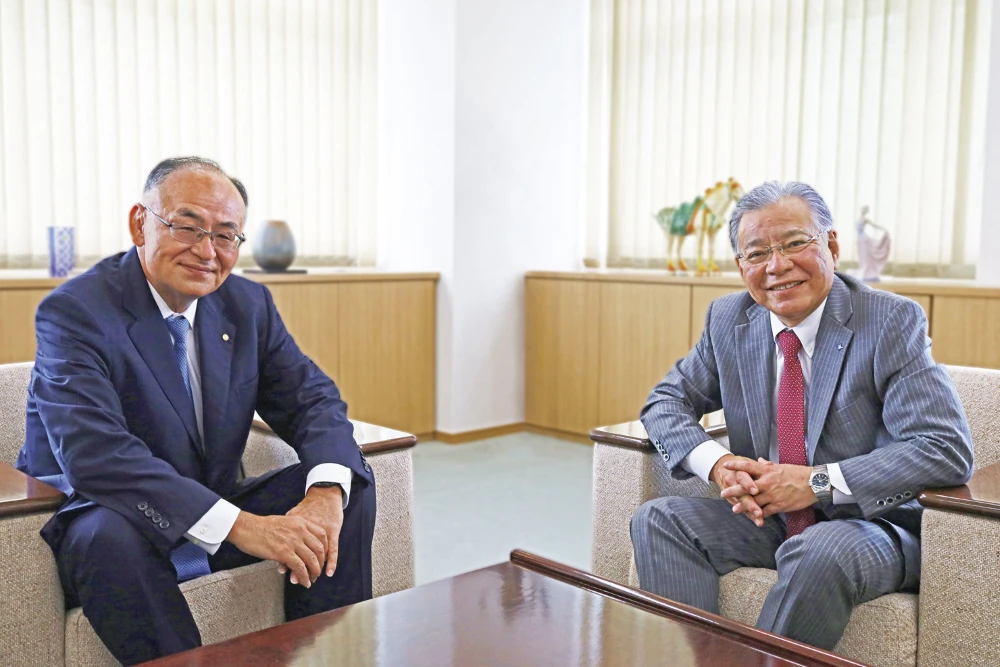
TAIHO KOGYO CO., LTD
President
Koichi SUGIHARA
Tokyo Seimitsu Co., LTD
President & CEO
Hitoshi YOSHIDA
About President Sugihara’s university days
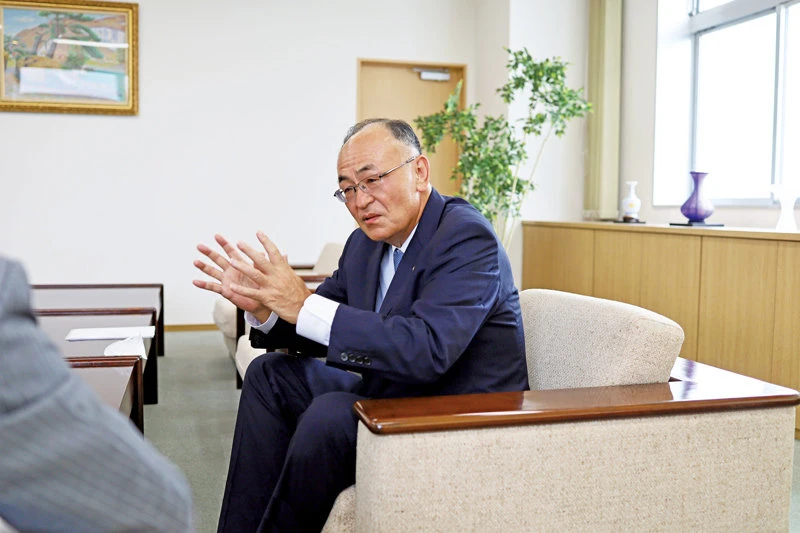
Yoshida
What were your university days like?
Sugihara
When I joined university, I immediately signed up for rugby, which I’d been doing all through junior and senior high school. Back then, the rugby team also had to compete against Waseda, Meiji and Keio just like the baseball club, so I had to train rigorously. I entered the Department of Aeronautics, Faculty of Engineering in my third year. I had to write a thesis and complete a design in order to graduate, so every day of my fourth year was a major struggle. I was overwhelmed with experiments and design drawings at the same time as having to keep up my rugby training. Our rugby club field was at Komaba Campus while the Department of Aeronautics was at Hongo Campus, not to mention my dorm was a 15 minute walk from Denenchofu station on the Toyoko Line so my typical day when I was a 4th-year university student was to wake up early, spend 1.5 hours travelling to Hongo, carry out experiments and work on my thesis until 2 pm, spend an hour travelling to Komaba and do rugby training from 3 until 7 or 8 at night. After training, I’d often return to Hongo to do experiments until late at night, then catch the last train home.
Yoshida
It seems your university years were demanding. Is the experience you had in that time of your life proving useful to you in your work now?
Sugihara
Because I couldn’t work part-time jobs and stayed at a dorm in Tokyo, I was desperate to graduate so I wouldn’t burden my parents. One day I fell asleep on the last train heading home and ended up in Musashi Kosugi. I had to cross Tama River to get back to the dorm.
It was going to take so long if I went all the way to a pedestrian bridge. Under statute of limitations, enough time has passed for me to tell you this, but because I was so exhausted, I decided to walk along the train tracks as a shortcut and finally made it back to my dorm. I really felt I’d done such a reckless thing. However, the physical and mental strength I cultivated during this time has helped me in my working life also, I think. Such exertion is the exact opposite of the work style reforms being focused on these days.
What he struggled with after joining Toyota
Yoshida
What were your first years of your career like?
Sugihara
When I joined Toyota in 1980, Japan's automobile production had exceeded 10 million units, surpassing the United States to become the highest in the world, and Toyota's exports exceeded 1 million vehicles for the first time. After the two oil crises, the fuel efficiency and price of Japanese cars earned them a strong reputation, and their popularity increased. However, trade friction between Japan and the U.S., our largest export destination, began to heat up, and Toyota’s leap to become a global company leading to in-country production began at that time.
With the advancement of design and production technologies, the drive and steering system of vehicles changed from the conventional FR system (front engine rear drive) to the FF system (front engine front drive) whereby the drive and steering systems were concentrated toward the front of the vehicle. This change had the benefits of improving straight-line stability and reducing vehicle weight.
At the same time, due to the shortening of the body length of compact cars and the expansion of the vehicle interior, the engine and transmission also underwent major reform and transverse layout became mainstream. I think that the excellent fuel efficiency and price offered by Japanese cars were made possible because we were able to advance these technological developments first. It was a time of change, but it was a vibrant and enjoyable time for young engineers.
Against this backdrop, I was assigned to a new organization called the Production Engineering Development Department, which was responsible for the mass production of the parts necessary for the FF and fuel efficiency of vehicles, as well as develop manufacturing methods to achieve this. I was involved in shifting to in-house production of parts such as turbochargers to improve small-displacement engine output and rack-and-pinion-type steering for FF.
Yoshida
What did you actually struggle with after joining Toyota?
Sugihara
I’m sure everyone experiences this, but there are many major disparities between university life and being a member of the work force. Due to this, I found myself in situations I will never forget. This is something that happened to me when I took my drawings to the team leader at the prototype plant to have a part I’d designed myself made up for me. The team leader politely told me “This is just a pretty picture. You can’t machine a part from this. Manufacturing involves processes, so drawings have to include these processes.” In other words, he taught me that a drawing should indicate what the part will look like after completing a certain process as well as what it will look like after the following process, therefore could not be used to manufacture a part if it only indicates the shape and tolerance that the designer needs.
Toyota has a concept of “kosakuzu,” or “working drawings,” which show the state of a mass-production part in mid-production. I learnt that a working drawing was an important tool promoting so-called “Own Process Completion” whereby the quality criteria for each process is clear and quality is infused in each process. Surprisingly, own process completion is difficult and cannot be achieved unless the standards of both equipment and quality control are raised. I learnt that there were quite a lot of companies that forgot to instill quality at each process and ultimately were left with only the final process to correct any product defects that had occurred up until that point.
Yoshida
After you were assigned to your specific department, which parts did you oversee the transition to in-house manufacturing for?
Sugihara
As I mentioned earlier, I was in charge of in-house manufacturing for turbochargers. We had been purchasing turbochargers for passenger vehicles from long-established U.S. company, Garret, however had to shift to in-house manufacturing due to our higher production volume. I was assigned to the team responsible for such a task and was given the task of developing equipment for the machining, assembling, and evaluation of bearing housing.
In order to support the shaft that rotates at high speed, a sliding bearing floating in engine oil is used, but the honing of small diameters requires roundness, cylindricality, and a plateau surface of µm (micrometer) level. To ensure accuracy, we modified the old honing machine used for engine bores, but there was no tool suited for the small diameter of bearing housing. Hence, we imitated others to design and fabricate a honing tool and grinding wheel. Now turbochargers easily exceed 200,000 RPM, but back then I had to try again and again to clear my target of 100,000 RPM. For assembly, we created a final inspection device, but since it is a waste to use exhaust gas by burning gasoline for single evaluation, we designed an evaluation device using factory air.
Not to mention, it was such a struggle to reach the mass production stage because all the technologies were new to us, including lost wax casting for making turbines with high heat-resistant nickel alloy, plaster mold method for making impellers, and friction bonding of chromoly steel and nickel alloy, but looking back now, it was a time when I learnt a lot, ranging from design technology to materials and manufacturing methods.
After that, the technologies of running, turning, and stopping evolved further, and an increasing number of vehicles on the market incorporated electronic control, so we began activities to develop electronic control of the power steering and shock absorbers manufactured in-house. From 1989 to 1993, I was stationed in Detroit for joint research with aerospace companies and research institutes. My research also looked at fuel cells.
Even back then, Toyota was focused on fuel cells and had a plan to make them in-house. Unfortunately, it took quite some time for FCVs to penetrate society to the point justifying mass production, but the infrastructure was developed and MIRAI was finally released 25 years later in 2014.
Now that I am a president of a company myself, I think back to those times and realize that, as cars evolved significantly toward front wheel drive, compact size, and good fuel efficiency, Toyota had to make a leap forward as a global company to eliminate friction with the U.S. The industry is developed to the extent it is today thanks to the philosophy and judgment of company executives at that time who were laying the foundations for the future autonomously. However, unlike now, I think time went a little slower back then so we had the leeway to just try making something, then worry about the result afterwards. I learnt how to be meticulous and move continuously toward a goal. At the pace of those years, we may not be able to keep up with today’s once-in-a-century period of major reform (laughs).
Yoshida
Wow. It’s thanks to people like you, President Sugihara, who carved the path forward in the past that we have the major reform of today. I don’t know how things will ultimately proceed, but I have a feeling that fuel cells will remain.
About work at Taiho Kogyo
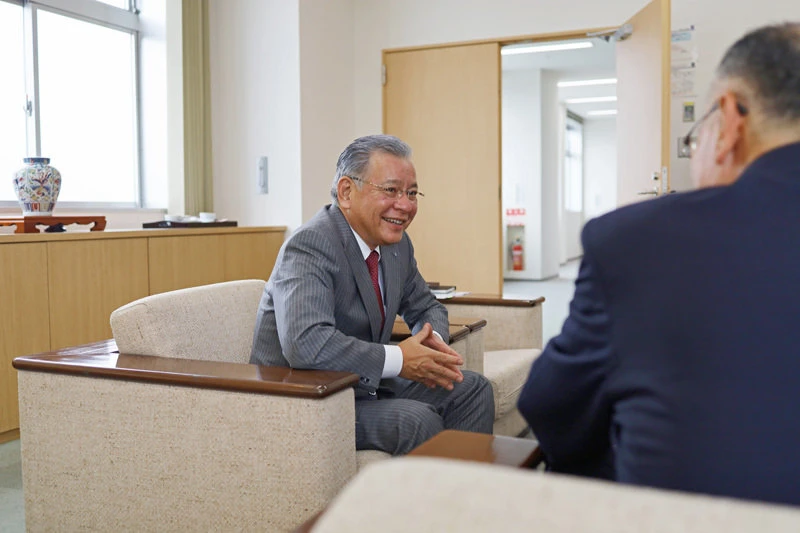
Yoshida
When did you join Taiho Kogyo?
Sugihara
I transferred from Toyota in 2014 and became president in 2015. Taiho Kogyo originally specialized in metal bushings for engines (called engine metal) and has a 76-year-long history. I was in charge of engine factories in Japan and overseas during my time with Toyota, and Taiho Kogyo was handling not only engine parts but also functional parts for driving and steering systems, so I was very well-versed in these parts because I’d made then in-house at Toyota, but I was also familiar with Taiho.
Yoshida
I think you have seen and experienced a lot over time. Based on that experience, what was the first thing you focused on when you joined Taiho?
Sugihara
Including my time stationed abroad, I was involved with in-house part manufacturing transition under the Production Engineering & Development Dept. for 17 years. Since becoming Section Manager, I was assigned to the manufacturing shop floor and managed parts/vehicle factories both in Japan and abroad for 20 years. Because of that background, when I began at Taiho, I first focused on production processes and shop floor strength.
Yoshida: The shop floor is where you see the workers in their true light, and it’s definitely the best spot to work from if you’re in the manufacturing industry.
Yoshida
The shop floor is where you see the workers in their true light, and it’s definitely the best spot to work from if you’re in the manufacturing industry.
Sugihara
Precisely. Bushings for engines are small parts, but they are very important parts that should never seize up. For this purpose, know-how is required for blending coarse material as friction material, and high accuracy is required of the molding and machining processes. Taiho’s strength is that it fulfills both of these requirements due to its practice of integrated manufacturing whereby it makes a product from material. Moreover, Taiho not only covers machining but also most elemental technologies in the production process for parts such as casting, metal atomization, rolling, sintering, heat treatment, press molding, plating, and resin coating. Each area is quite in-depth, and when I go to the manufacturing shop floor, I always learn something new.
Sense of future direction
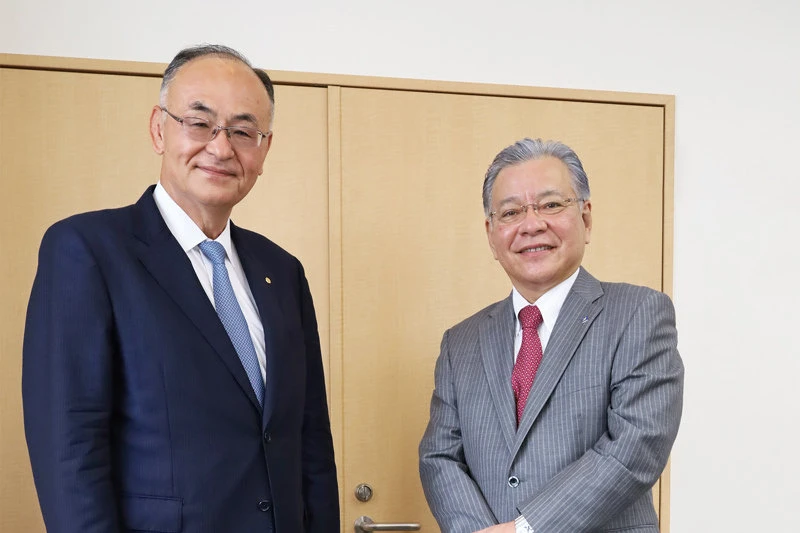
Yoshida
Did you have a sense of how you wanted the company to change when you became president?
Sugihara
The very first thing I sensed when I became president at Taiho was that both the company and individual employees had walls all around them, and to put it nicely, everyone worked solemnly within their own capacities. In normal times, that can be considered a strength, but in this current fast-changing era, the whole company must unite and exhibit both creativity and speed. That is why I dedicated myself to sharing the company vision and direction with every employee, prepared Taiho’s original work ethos, started running ekiden marathons to foster unity and so forth.
These efforts resulted in livelier communication within the company and helped remove the walls, so we could become a company united as one. Also, when I first joined the company, the main form of interaction between superiors and subordinates, particularly on the shop floor, was OJT, however, there was a lot of tacit knowledge, and everyone’s style of teaching varied. When I go to provide support overseas it is sometimes really apparent to me how the capacity and teaching style of Japanese support team members differ, resulting in the local operators becoming confused. In light of this, I focused on putting that tacit knowledge into a tangible form and had the individual shop responsible for each elemental technology compile a written document, then launched “Skill-up System” as a program to train personnel with one, common way of teaching. This program made it possible to integrate the style of teaching from senior to junior workers and in turn further promoted a culture of teaching and being taught as Taiho’s foundation.
Yoshida
Now is a transitional period in terms of human resource development, etc. as we go through work style reform. Tokyo Seimitsu is also considering various approaches. We touched upon this a little earlier, but in terms of the industry also, the entire automotive industry is currently in a once-in-a-century time of great reform. Which direction do you think Taiho will take as the industry changes significantly?
Sugihara
Taiho’s main products are engines and drive parts, therefore, I am worried there will be a major impact on our company due to the growing popularization of 100% electric vehicles. Right now, we have hardly nothing to do with electric or electrical components, so we need to consider trying our hand at something new. If we describe our existing products as “defense” and new areas as “offense,” defense-wise it is important that we refine and improve conventional products to increase our competitiveness, while offense-wise, we must search for new areas and challenge ourselves to succeed at these. Both these offense and defense tactics are crucial to our company’s survival. In terms of existing engines, HV and PHV still prevail, and there is still quite a demand especially if we include the untapped Chinese market, so that is where I want to aim. Price is one factor to competitiveness, but in addition to price, Taiho will enrich our development of manufacturing methods, design technology, etc., to give us an even better competitive edge.
Yoshida
In other words, you want to increase accuracy while lowering cost. I also believe that accuracy requirements will continue to intensify moving forward. For the time being, engines won't be eliminated all entirely, rather there will be a period of hybrid cars. Also, in addition to engines, I think bearings will remain a necessary vehicle part. In which case, there will be demands relating to fuel efficiency, noise, etc., and in line with this, even higher accuracy will be required. That is how I predict things will be.
Sugihara
In China, electrification of vehicles is being advanced by the government, however, motorization is progressing and people are driving at fast speeds and longer cruising distances. We have more interest from OEMs seeking Japanese engine bearings due to their high reliability and high output/high rotation without seizure. Moreover, not only in regards to gasoline-drive vehicles but also diesel vehicles, in order to meet the requirements of Euro 6 vehicle emission standards, we are attempting to increase compression rate to improve combustion efficiency. For this reason, the bearing material must be able to withstand an even higher surface pressure. This is an area where we can harness our material technologies, so we are also strengthening our raw material bases in China.
Both Toyota and Taiho Kogyo have been well cared for by ACCRETECH's various precision measuring machines. Particularly in the area of machining where I worked, we needed measuring equipment for all aspects, both in-line and off-line and in the measuring room, to secure accuracy of the I.D/O.D., roundness, cylindricity, flatness, roughness, and shape. When I worked for the Production Engineering & Development Dept., if I was in a hurry I would prototype what I’d designed then measure it myself, and I was able to use almost all of the measuring equipment we had. Back then, things were primarily manual, but I was also able to prepare fixtures and align the machines before measurement. Nowadays that kind of alignment, etc., is corrected automatically, so it’s not something I can boast about, but back then, mass production machining lines were usually dedicated lines comprising of individual SPMs (special-purpose machines) connected into the flow. This is okay for large-volume production, but when part variety increased or design changes were made, we would have to set up the measurement machine all over again, and this was very time-consuming. These days, general-purpose machines have better performance and are capable of combined machining, so the mainstream approach is cell production in which all processes are integrated. We organically transitioned from an era where special-purpose measuring equipment was installed within a line, to an era where measurements could all be taken care of by a general-purpose CMM. In my generation, I saw measuring equipment transition from manual to electronic, but many more factors are also changing in terms of tangible and non-tangible elements.
Yoshida
Even at Tokyo Seimitsu, we’ve seen the change from conventional contact-type measuring to non-contact type and predict that non-contact needs will increase even further. To achieve further cost reduction, increasing takt time will be imperative, so we’d like to make it possible to measure products in-line as they are being machined and reflect measurement results into production processes instantly. We must also rise up to new challenges moving forward or we won’t be able to grow any further. Together with customers such as Taiho Kogyo, we are looking forward to embarking on our journey into these new frontiers.
TAIHO KOGYO CO., LTD
Began operation in 1944 in Midorigaoka (current headquarters) in Toyota city, Aichi prefecture. Mainly produces bearing products and aluminum die-cast products to support the automotive industry. Practices integrated production for a variety of products, and leverages this approach, which fuses diverse manufacturing technologies (e.g.casting, precision processing, mounting, assembly, and conveyance)with advanced quality control technologies to swiftly respond not only to existing product needs, but also to the launch of new products.

